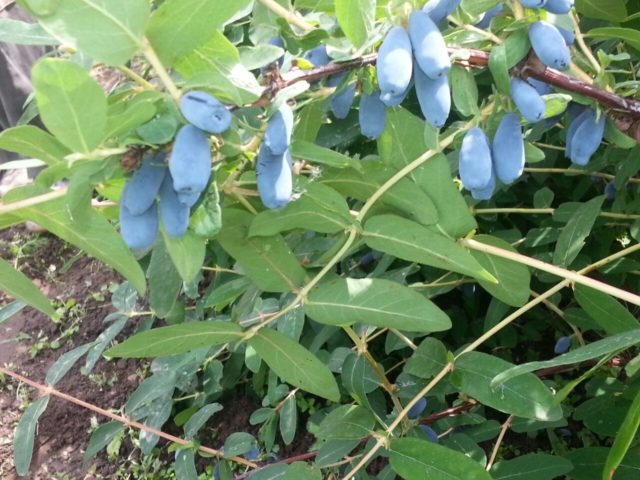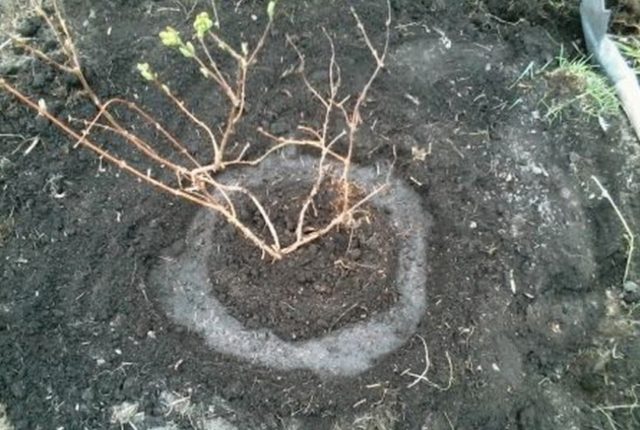Content
- 1 Description of Nizhny Novgorod early honeysuckle
- 2 Planting and caring for Nizhny Novgorod early honeysuckle
- 3 Reproduction of edible honeysuckle Nizhny Novgorod early
- 4 Pollinators of honeysuckle variety Nizhegorodskaya early
- 5 Diseases and pests
- 6 Conclusion
- 7 Reviews of the Nizhegorodskaya early honeysuckle variety
The Nizhegorodskaya early honeysuckle variety is suitable for the middle zone in terms of its properties. The culture requires infrequent watering and feeding, it is more selective to the place of growth. Planted in a group of several pollinators, it produces a good harvest.

Bushes of the variety are not tall, convenient for harvesting
Description of Nizhny Novgorod early honeysuckle
The bush of the dessert variety Nizhegorodskaya is early medium-sized, up to 1.4-1.7 m. A dense spherical crown is formed by erect medium-leafy trunks. The leaf blades are of medium size, elongated, lanceolate, dark green. The root system of honeysuckle is superficial, fibrous. 1.6 m is left between the planting pits for honeysuckle. It begins to bear fruit in the 3rd year after planting.
In Nizhny Novgorod, early fruits begin to ripen by mid-June, when the skin is covered with a characteristic blue color. The size of the oval-elongated honeysuckle berries of the early maturing variety is 12-16 mm. Berries of medium weight, from 80 to 120 mg. From the beginning of growth, the fruits are green, then the flesh and skin turn dark blue, a waxy coating remains on top. The fruits of Nizhny Novgorod early belong to the table, have a sweet and sour invigorating taste.
One bush of Nizhny Novgorod early honeysuckle gives 3-3.8 kg. Ripening of berries in a month and a half after flowering, depending on the geographical location - already at the end of the first or in the second decade of June.
Shrubs of canteen honeysuckle at the age of 5-6 years produce more than 5 kg of berries with good care:
- timely watering;
- competent feeding;
- disease prevention.
When choosing varieties, gardeners note the advantages of Nizhny Novgorod early honeysuckle:
- medium-sized fruits;
- pleasant taste of berries, in which there is no bitterness;
- early maturity and amicable ripening;
- dry separation of fruits;
- frost resistance of the shrub.
Due to these characteristics, the sweet honeysuckle of Nizhny Novgorod is grown in private farmsteads and large agricultural enterprises. The disadvantages are the properties characteristic of most varieties of culture: the fruits ripen very quickly, and with a delay in picking, overripe berries crumble.
The crop is harvested when the flesh and skin are evenly blue. In this phase of ripeness, the berries acquire their characteristic refreshing, sweet and sour taste. When collected, they are placed in small half-liter containers. Stored in the refrigerator for two weeks.
The most valuable characteristic of plants of the Nizhegorodskaya early variety is winter hardiness and immunity to spotting.

Nizhegorodskaya early berries are small, but tasty
Planting and caring for Nizhny Novgorod early honeysuckle
Honeysuckle seedlings have a fibrous root, the shoots should be elastic when purchased, not dry. 2-5 hours before planting, the plant is placed in a liquid clay mash so that the roots are saturated with water.
Landing dates
The Nizhegorodskaya early honeysuckle variety is advised to be planted from the first warm days of spring in March or April.In a plant, the buds begin to swell very early, so the shrub is moved almost immediately, when the soil allows you to work in the garden. Culture also has an early period of dormancy. From the end of July, even yellowing and leaf fall occurs. Therefore, at the beginning of August, honeysuckle is already transplanted, until the end of September in the warmer regions of the middle lane.
Selection and preparation of the landing site
Light sandy areas are suitable for Nizhegorodskaya early honeysuckle. Although the unassuming culture grows on other soils, loams and sandy loams.
Honeysuckle prefers:
- neutral or slightly acidic soil pH 6-6.5;
- sunny area, because with a lack of lighting, the berries become less sweet, the yield decreases;
- a place protected from northern winds, it is convenient to place it along the fences;
- area without stagnant water.
Landing rules
For honeysuckle, planting holes are dug small, 40 cm deep and in diameter. Garden soil is mixed with organic matter, sand is added to clay soils. The substrate is enriched with 500 ml of wood ash, 70-150 g of superphosphate, 30 g of potassium sulfate.
Having established a seedling, straighten the root processes, cover it with a substrate. The root collar is deepened by 3 cm. The compacted soil is watered, mulched. After planting, the bush is cut off, shortening the shoots by only 2-3 cm.
Watering and feeding
The drought-resistant variety Nizhegorodskaya early does not need frequent watering. In dry periods, the seedling is watered once a week, adult bushes - 2-4 times over the summer. The rate of water consumption is 10-15 liters under the bush. In drought, plants are refreshed by sprinkling. If there is no mulch, the soil is regularly loosened, weeds are removed from the trunk circle.
Honeysuckle is fed infrequently, once every 3 years. Fertilizers are applied in early spring, spreading horse humus or compost, any nitrogen fertilizers under the bushes. With the growth of the ovaries, the culture is fed with a mixture of 30 g of potassium sulfate and 50 g of superphosphate.
Pruning
Proper pruning of honeysuckle helps to increase yields. Fruit buds of the next year are formed on the growth of the current one. Therefore, the tops of the shoots are not cut off. Branches are removed if they thicken the bush or are damaged. In autumn and spring, only sanitary pruning is carried out. Early Nizhny Novgorod honeysuckle is rejuvenated after 8-10 years of growth, shortening the shoots not by a stump, but leaving 20-30 cm. Trunks older than 15 years are removed.
Important! The tops of the shoots, new growth, are not cut off, since flower buds have formed on them since summer.

The main requirement for the planting site of honeysuckle is soil fertility
Wintering
Early Nizhny Novgorod honeysuckle can withstand frosts down to -40 ° C. Only young seedlings are sheltered after moisture-charging irrigation and mulching. Harvest bushes are covered with a fine mesh from bullfinches, which feast on buds.
Reproduction of edible honeysuckle Nizhny Novgorod early
Every gardener will easily propagate the culture by cuttings and layering. Cuttings are cut in March, before flowering, from the healthy growth of the previous year with buds. The twigs are planted in the garden or greenhouse without deepening the buds. From above they are covered with a mini-greenhouse. Layers are added dropwise after flowering, fixed in the ground with staples. The sprouts are transplanted after a year.
Pollinators of honeysuckle variety Nizhegorodskaya early
The variety is partially self-fertile. But, like most varieties of honeysuckle, self-pollination brings no more than 20-30% of the harvest. The best pollinators are seedlings of the Nizhny Novgorod selection, for example, Kuminovka and Lakomka.
Diseases and pests
Nizhegorodskaya is resistant to olive spot, can be affected by other diseases. They are warned by collecting fallen leaves and treating the shrub in spring with copper sulfate along with other plants. In case of signs of infection, new generation fungicides are used.
The crop is weakened by attacks by caterpillars or fruit pests.Insecticides are used in large quantities against insects.
Conclusion
The Nizhegorodskaya early honeysuckle variety is resistant to pests, diseases and low temperatures. It takes root in most of the country and pleases with the June harvest of delicious berries.








